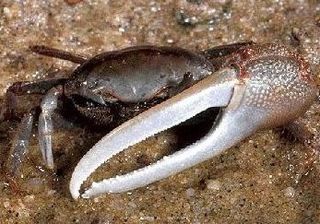Top Qs
Timeline
Chat
Perspective
Chelae
Pincer-like organ terminating certain limbs of some arthropods From Wikipedia, the free encyclopedia
Remove ads
A chela (/ˈkiːlə/) – also called a claw, nipper, or pincer – is a pincer-shaped organ at the end of certain limbs of some arthropods.[1] The name comes from Ancient Greek χηλή, through Neo-Latin chela. The plural form is chelae.[2] Legs bearing a chela are called chelipeds.[3] Another name is claw because most chelae are curved and have a sharp point like a claw.



Chelae can be present at the tips of arthropod legs as well as their pedipalps. In some pseudoscorpions, the chelate pedipalps can be venomous.[4] Chelae can be functionally overlapping with chelicerae, which specifically refers to appendages used as mouthparts in Chelicerata. In spiders those usually contain venom glands, but in other chelicerate allies the chelicerae can be chelate without venom glands.[5]
Remove ads
Uses
Summarize
Perspective
Chelae have a wide variety of uses, but most commonly they are used for handling prey and for defense. These uses are often reflected in the morphology of the chelae. For instance, some species, such as the members of the families Ocypodidae and Alpheidae show asymmetry between their paired claws.[6] Possessing one enlarged chela used for defensive and courtship purposes and a smaller chela for shearing and feeding. For some species, this asymmetry between chelae may be a sexually dimorphic trait. whereas in others, like many species of scorpions, it is not.[7] An example of specialization of these asymmetrical chelae can be seen in the Alpheus heterochaelis, the bigclaw snapping shrimp. The enlarged snapping claws of these shrimp are capable of snapping shut with such force to shoot a jet of water and create a loud popping noise, which they use to deter predators and other members of their species.[6]
In scorpion species, the chelae are often used to grab hold of prey and then further subdue them by injecting them with the venom from their stingers, although some species rely solely on the chelae to subdue their prey. Scorpions also use their chelae for defense by using them to shield and protect their bodies. For scorpions, the chelae are formed at the end of the pedipalps and covered in sensory hairs that they use in a similar manner to insect antennae. [7]
Further uses of chelae include digging, burrowing, and climbing. Chelae also play an important role in many species mating rituals, such as to communicate and attract prospective mates, wherein species with asymmetrical chelae use their enlarged chela as a display to attract mates. Chelae are also used in the act of mating, where the male species will often use them to hold onto the female during the act.[7]
Remove ads
See also
References
Wikiwand - on
Seamless Wikipedia browsing. On steroids.
Remove ads
